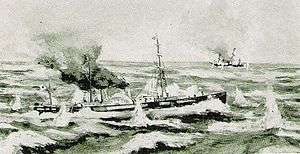Japanese warship Kasuga
 | |
| History | |
|---|---|
| Name: | Kasuga |
| Builder: | J. Samuel White of Cowes, Isle of Wight, UK |
| Launched: | 1860 |
| Acquired: | January 1868 |
| Decommissioned: | 1894 |
| Fate: | Scrapped 1902 |
| General characteristics | |
| Displacement: | 1,269 long tons (1,289 t) |
| Length: | 73 m (239 ft 6 in) |
| Beam: | 9 m (29 ft 6 in) |
| Propulsion: | Coal-fired steam engine, 300 ihp (220 kW) by Day & Co. of Southampton |
| Speed: | 17 knots (20 mph; 31 km/h) |
| Complement: | 134 |
| Armament: | 6 guns |
Kasuga Maru (春日丸) was a Japanese wooden paddle steamer warship of the Bakumatsu and early Meiji period, serving with the navy of Satsuma Domain, and later with the fledgling Imperial Japanese Navy.
Boshin War
Kasuga Maru was built in 1860 in Great Britain by J. Samuel White of Cowes, Isle of Wight under the name Keang Soo (after the area of Jiangsu in China) as an armed cargo vessel. While at Nagasaki, Keang Soo was purchased by Matsukata Masayoshi, a leading Satsuma samurai, on November 3, 1867, for the amount of 160,000 ryō (approx $250,000 at then current exchange rates), whence she was renamed Kasuga Maru. With a speed of 17 knots (31 km/h), and six cannons, she was faster than anything in the Tokugawa shogunate Navy, and Matsukata intended to convert her into a warship. However, already alarmed by the high cost, as the price was four times the budget Matsukata had been authorized, he was overruled by the Shimazu clan elders. She was assigned to be used as a cargo ship. In disgust, Matsukata gave up command of the ship he had bought, only to see it converted into a warship just a few months later under the command of his assistant, Akatsuka Genroku.
Kasuga Maru entered Hyōgo harbour in January 1868, where she was blockaded by three ships of the Tokugawa Navy: Kaiyō Maru, Banryū Maru and Shōkaku Maru. Tōgō Heihachirō, future Admiral of the Fleet, joined the ship on January 3 as a third-class officer and a gunner. The night of January 3, Kasuga Maru escaped from Hyōgo harbour with two other ships. She was spotted by Kaiyō Maru, which chased her into Awa Strait. The two ships exchanged fire at a distance of 1,200-2,500 meters, without any actual hits. The exchange was named the Naval Battle of Awa and was the first naval battle in Japan between two modern fleets. Kasuga Maru returned to Kagoshima after that exchange.
In March 1869, Kasuga Maru participated in the expedition against the last remnants of the pro-Tokugawa forces in Hokkaido, where they had formed the Republic of Ezo with the support of a few French military advisors such as Jules Brunet. While at Miyako Bay, the expedition suffered a surprise attack by the Bakufu ship Kaiten. Kaiten attacked the state-of-the art ironclad ship Kōtetsu, but she was repulsed by Gatling guns on board the Kōtetsu and cannon response by Kasuga Maru. The encounter has been named the Naval Battle of Miyako Bay. After these events Kasuga Maru participated in the Naval Battle of Hakodate Bay in May 1869, until the surrender of the last forces of the Republic of Ezo.

Imperial Japanese Navy
In April 1870, Kasuga Maru was transferred from the Satsuma Domain to the Meiji government and assigned to the newly formed Imperial Japanese Navy, and was renamed Kasuga at that time. In 1872, under the command of Itō Toshiyoshi, she carried Japanese envoys to Korea as part of Japan's ongoing attempts to obtain diplomatic recognition from Joseon dynasty Korea. The failure of this mission was one of the underlying factors in the subsequent Ganghwa Island incident of 1875, during which Kasuga was assigned to blockade the port of Busan. Under the command of Inoue Yoshika, Kasuga was also one of the ships which participated in the Taiwan Expedition of 1874.
Kasuga was demobilized in 1894 and then assigned to the mine-laying group at Tsushima. She was sold for scrap in 1902.
References
- Reischauer, Haru Matsukata. Samurai and Silk: A Japanese and American Heritage. Cambridge, Massachusetts: The Belknap Press of Harvard University Press, 1986. ISBN 0-674-78800-1.
- Haraguchi, Izumi. The Influence of the Civil War in the US on the Meiji Restoration in Japan. South Pacific Study Vo.16 No.1 (1995)
- Jane, Frederick Thomas. The Imperial Japanese Navy. Nabu Press (2010 reprint of 1923 edition) ISBN 1-142-91693-6
- Jentschura, Hansgeorg; Jung, Dieter; Mickel, Peter (1977). Warships of the Imperial Japanese Navy, 1869–1945. Annapolis, Maryland: United States Naval Institute. ISBN 0-87021-893-X.
| ||||||||||||||||||||||||||||||||||||||||||||||||||